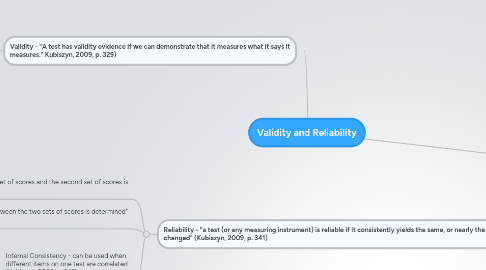
1. Validity - "A test has validity evidence if we can demonstrate that it measures what it says it measures." Kubiszyn, 2009, p. 329)
1.1. Content Validity Evidence - "a test with good content validity evidence matches or fits the instructional objectives" (Kubiszyn, 2009, p. 330)
1.2. Criterion-Related Validity Evidence - "In establishing criterion-related validity evidence, scores from a test are correlated with an external criterion." (Kubiszyn, 2009, p. 330).
1.2.1. Concurrent Criterion-Related Validity Evidence - measures being correlated are administered at same time (Kubiszyn, 2009, p. 330)
1.2.2. Predictive Criterion-Related Validity Evidence - "how well the test predicts some future behavior of the examinees" (Kubiszyn, 2009, p. 331)
1.3. Construct Validity Evidence - relationship between test and a theory (Kubiszyn, 2009, p. 332)
2. Reliability - "a test (or any measuring instrument) is reliable if it consistently yields the same, or nearly the same, ranks over repeated administrations during which we would not expect the trait being measured to have changed" (Kubiszyn, 2009, p. 341)
2.1. Test-Rest or Stability - "test is given twice and the correlation between the first set of scores and the second set of scores is determined" (Kubiszyn, 2009, p. 341)
2.2. Alternative Forms or Equivalence - Two "forms are administered to a group of students, and the correlation between the two sets of scores is determined" (Kubiszyn, 2009, p. 343)
2.3. Internal Consistency - can be used when different items on one test are correlated (Kubiszyn, 2009, p. 343)
2.3.1. Split-Half Methods - "each item is assigned to one half or the other. Then, the total score for each student on each half is determined and the correlation between the two total scores for both halves is computed." (Kubiszyn, 2009, p. 343-344)
2.3.2. Kuder–Richardson Methods - "These methods measure the extent to which items within one form of the test have as much in common with one another as do the items in that one form with corresponding items in an equivalent form" (Kubiszyn, 2009, p. 344)
